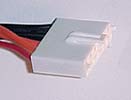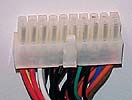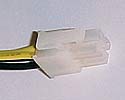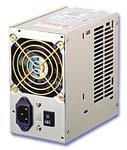Now unless you've
recently upgraded your power supply to something a little more powerful, you will
need to look for at least a 300W P4 capable PSU. We've always been partial to
the Enermax line since they are fairly inexpensive, high wattage, and very
quiet. The added power cables necessary for P4 compliance are somewhat of a
recent phenomenon to many of the Enermax PSU's, so if you do consider getting
one be sure to look at the power connectors to see if it is the most current evolution.
When selecting the right power supply you need to look
first at the wattage of the unit then at the types of power connectors it has.
Generally, an appropriate powersupply should be at least 300W. In terms of power
connectors, the P4 motherboard requires no less then three sources of
electricity. Two of the connectors will be relatively new to many of you.
| ATX 5V/3V |
ATX Power |
ATX 12V |
 |
 |
 |
Main power and "instant power on" functionality still
comes to the board through the standard ATX power connector we are all familiar
with. Additionally, there are also the ATX 12V and ATX 5V/3V power connectors.
All three must be connected to the motherboard for it to function, so a power
supply without them won't be of much use. The ATX 12V line supplies extra power
to the processor, and the 5V/3V line supplies extra power to on-board components.
| Component No. 5: P4 compliant PSU |
 |
| Example: Enermax
EG451P-VE |
So there you have it, upgrading to the P4 platform will
require a host of new components designed especially for this powerful processor.
Apart from the case, just about every major component will need to be P4
compatible - a huge change from the easy upgrade paths we have all enjoyed for the past few years.
To recap, in order to upgrade to
the P4 from a current Intel or AMD solution you will need the following gear without
exception: processor, motherboard, RIMM memory, heatsink and power supply - all of which need to
be P4 compliant. Granted this raises the cost of an upgrade, but
if you have to have one of the highest-clocked processors on the market this is the
price you'll need to consider.
Thankfully there is a lot of backwards compatibility
with many of these components, so if you are a power user you may already be
using them in your system.
